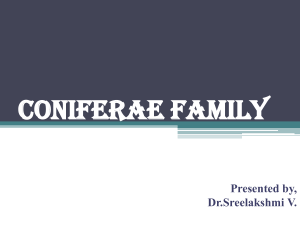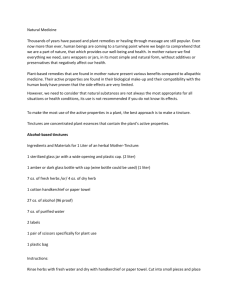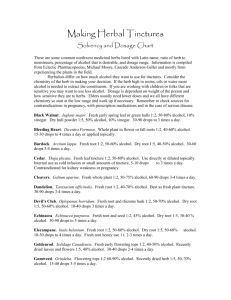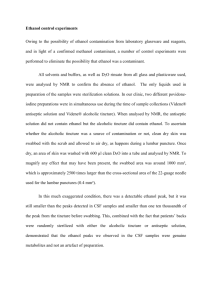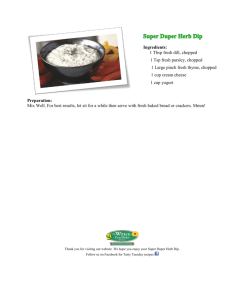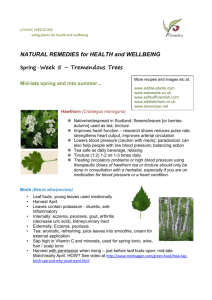LESSON EIGHT QUIZ Master Sheet #1 1. To reiterate, when the
advertisement
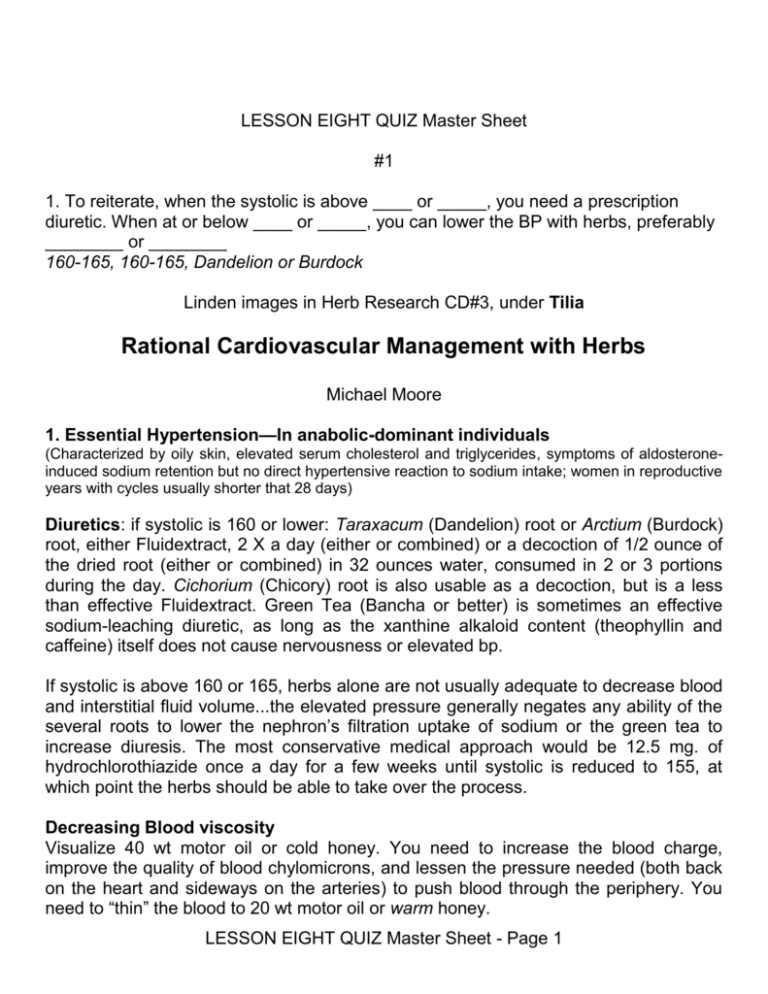
LESSON EIGHT QUIZ Master Sheet #1 1. To reiterate, when the systolic is above ____ or _____, you need a prescription diuretic. When at or below ____ or _____, you can lower the BP with herbs, preferably ________ or ________ 160-165, 160-165, Dandelion or Burdock Linden images in Herb Research CD#3, under Tilia Rational Cardiovascular Management with Herbs Michael Moore 1. Essential Hypertension—In anabolic-dominant individuals (Characterized by oily skin, elevated serum cholesterol and triglycerides, symptoms of aldosteroneinduced sodium retention but no direct hypertensive reaction to sodium intake; women in reproductive years with cycles usually shorter that 28 days) Diuretics: if systolic is 160 or lower: Taraxacum (Dandelion) root or Arctium (Burdock) root, either Fluidextract, 2 X a day (either or combined) or a decoction of 1/2 ounce of the dried root (either or combined) in 32 ounces water, consumed in 2 or 3 portions during the day. Cichorium (Chicory) root is also usable as a decoction, but is a less than effective Fluidextract. Green Tea (Bancha or better) is sometimes an effective sodium-leaching diuretic, as long as the xanthine alkaloid content (theophyllin and caffeine) itself does not cause nervousness or elevated bp. If systolic is above 160 or 165, herbs alone are not usually adequate to decrease blood and interstitial fluid volume...the elevated pressure generally negates any ability of the several roots to lower the nephron’s filtration uptake of sodium or the green tea to increase diuresis. The most conservative medical approach would be 12.5 mg. of hydrochlorothiazide once a day for a few weeks until systolic is reduced to 155, at which point the herbs should be able to take over the process. Decreasing Blood viscosity Visualize 40 wt motor oil or cold honey. You need to increase the blood charge, improve the quality of blood chylomicrons, and lessen the pressure needed (both back on the heart and sideways on the arteries) to push blood through the periphery. You need to “thin” the blood to 20 wt motor oil or warm honey. LESSON EIGHT QUIZ Master Sheet - Page 1 (A) You need to increase both the repelling charge of red blood cells so they don’t clump or tend to aggregate, and the repelling charge of the blood vessel walls so that blood regains better fluid mechanics (and doesn’t tend to stick to itself or blood vessels) Ceanothus (Red Root) root bark, preferably as a tincture, 30 drops in water, 3 X a day. “Hcl and pepsin” type tablets work for short-term use but have no sustained or lasting effect. Increasing dietary intake of citrus juice, vinegar and other non-nitrogenous natural acidulous foods is also helpful, as are the dietary supplements Vit. E (usually 800 i.u. a day), ascorbic acid (1000 mg a day, minimum), and that old standby, an aspirin every day or two. (B) You need to decrease the effect excess blood lipids have on diminishing the blood charge...its “sludge” factor. To do this you need to lower cholesterol and triglyceride levels (usually a slow process) and improve the efficiency of fat digestion. Herbally, Taraxacum, Arctium, the Araliaceae (Panax, Eleutherococcus, most Aralias), Allium (Garlic) 1-2 fresh cloves a day, and Curcuma (Turmeric) all help a bit. Supplements are more important, particularly Niacin (2-3 grams a day). This will cause you to sunburn from inside out, so use inositol hexaniacinimide instead...“no flush” niacin. Whole Turmeric is rather heating in large enough quantities to truly help, so a gram a day of refined 95% curcumin is usually preferable. Coleus forskohlii preparations help slow and strengthen the pulse (contra: beta blockers). Improving fat digestion is a bit more complex; Try a simple bitter before each meal Always eat something for breakfast (if only a salad) Avoid heroic consumption of fats at one sitting. Avoid large amounts of butterfat together with spicy foods. Avoid major fat or lipid intake in the evening. (C) Lessen stress. Every moment of anger or frustration or excess self-manipulation, in the anabolic-stress person, elevates cortisol and adrenalin (or at least increases adrenergic dominance) with accompanying cholesterol, triglyceride and glucose LESSON EIGHT QUIZ Master Sheet - Page 2 elevations, increased platelet aggregation and increased arterial tone. This makes the blood viscous all over again. Herbally, Passiflora (Passion Flower), Pedicularis (any species), Melissa (Lemon Balm), Nepeta (Catnip), or simply Matricaria (Chamomile) are usually the “coolers” of choice. Others, such as Valerian, Hops, Kava and Vervain tend to have strong secondary stimulus to either cardiovascular, intestinal tract or liver function and are usually contraindicated in the anabolic stress person. 2. Hypertension—In catabolic-dominant individuals (Characterized by dry skin, hypertensive “flairs”, tachycardia under stress, and increased blood pressure after salt consumption...salt reactors) (A) Avoid salt (duh!...still had to say it). Use lots of spices instead...get a collection of spice jars on the table, throw out the salt, and avoid snack foods as if the very plague. Roast your own nuts, bake your own chips (potato, corn, whatever), carry them around, all spiced (not salted) and become a ritual salt avoider. It’s not so important to check the sodium on every label...a single snack of Fritos or Planters will blow it all. (B) Keep around a supply of herbs that calm you down when you get agitated. SJW (Hypericum) works for a few, Pulsatilla (fresh herb tincture) may help in the evening (510 drops, usually), Avena sativa or A. fatua (Oats) tincture, made from the fresh immature seeds (when milky with starch latex) is useful (10-15 drops as needed)....and particularly Lobelia fresh herb tincture (3-10 drops). The trick here is to begin to get sensitive to the “adrenalin” rushes, and back them down with a quiet moment and the herb that works best. Until the catabolic hypertensive starts to “get in touch” with how often they get pissed off or upset, how often their pulse increases and their epinephrine flows, it is almost impossible to deregulate habits. The herbs help for the specific occasion, but only self-awareness can cure. (C) Use generous mineral supplements. Start with Magnesium—at least 500 mg a day—more if you live a major city, the American South or use a quality water filter. Calcium and phosphorus supplements may be needed but vegetable juices (except hyperglycemic carrot juice), dehydrated greens or “superfoods” are better sources. Avoid any specialized food supplements that give you a rush. Spirulina or blue-green algae or wheat grass are reasonable mineral sources, but if they make you happy, giddy and speedy they will just aggravate the whole process of adrenalin and bloodsugar spiking that is part of the problem. Coleus forskohlii helps stabilize both blood sugar and BP spikes. LESSON EIGHT QUIZ Master Sheet - Page 3 3. Hypertension or tachycardia in Thyroid-stress Individuals. (Characterized by rapid pulse, easy perspiration, loose stools) (A) Lycopus (Bugleweed) or Leonurus (Motherwort) tincture—at least 60 drops a day of either or both, with Lycopus being the most likely to work. (B) Use the root diuretics of anabolic stress and the calmers of adrenalin stress. ————— Remember: Hypertension or tachycardia as described here are functional imbalances only. I am not talking about cardiovascular disease, rather the stresses and imbalances that usually precede overt disease. High Blood Pressure is a necessary accommodation and should not, if possible, be directly suppressed just for the sake of cuff readings. One needs to change the NEED for high blood pressure. #2 ASTHMA Strategies of primary and support treatment with herbs Michael Moore THE MEDICAL MODEL (SIMPLIFIED) [Since most patients seeking herbal support for asthma come to us by way of Standard Practice Medicine, here is a brief review of the current medical model and treatment.] Asthma is an inflammation of the lungs which causes airways to narrow, making it difficult to breathe. During an asthma attack: * The muscles around the bronchi tighten making the bore of the bronchi smaller. * The lining of the bronchi swells (becomes inflamed) and produces mucus, making the opening in the airway smaller. Asthma can cause you to be highly sensitive to conditions that may not affect other individuals, such as: * grass, mold or ragweed (allergens) * smoke, paint or fumes (irritants) * viral infections -- colds, flu, sore throats * changes in air pressure and cold air * exercise The cause of asthma is unknown, but the disease tends to run in families and most asthmatics have allergies. Asthma varies greatly from one person to another. Symptoms can range from mild to moderate to severe. It is important to know that asthma is a long-term illness that can occur at any time in one's life. It is a serious disease with acute episodes (asthma attacks) that, if not properly treated, can be LIFE-THREATENING. LESSON EIGHT QUIZ Master Sheet - Page 4 HOW IS ASTHMA TREATED MEDICALLY? While there is no cure for asthma, there medications are available that help relieve symptoms and treat the underlying disease. As a first step, most doctors recommend eliminating or avoiding asthma "triggers." For example, if animal dander (tiny scales from hair, feathers or skin) is likely to cause an attack, you should avoid places where animals are present. However, since it is virtually impossible to avoid or remove all the "triggers" from the environment, your doctor may prescribe one or more medications to prevent or treat the asthma flare-up. TYPES OF MEDICATIONS Anti-Inflammatory Medicines: Reduce swelling of the lining of the bronchi and reduce mucus production. Best when used daily for moderate to severe asthma. o Oral Steroids such as prednisone and prednisolone can quickly reduce the inflammation of the bronchi during an "attack." o Inhaled Medicines such as cromolyn sodium and inhaled corticosteroids. They keep inflammation from starting and are used daily to prevent asthma attacks. Bronchodilators: Relax the muscles which have tightened around the bronchi. o Adrenergic bronchodilators (Beta-2 agonists) provide temporary relief of symptoms, but do not treat the inflammation. Available in aerosol form (inhaled) or tablets (oral). Tablets work slower and have more side effects. Bronchodilators are best when used infrequently to treat an acute attack. o Theophylline available in liquid, capsule or tablet form. When used in a time-released formula it has a long duration of action, making it particularly useful for the control of "night time" asthma. ASTHMA TRIGGERS Triggers are anything that make asthma worse. They most often include: o Respiratory infections such as colds, flu, sore throats and bronchitis o Allergens (substances to which people are allergic) like pollens, foods, dust, mold, feathers, or animal dander (small scales from animal hair or feathers) o Air irritants such as dirt, cigarette smoke, gases and odors o Exercise o Emotional stress o Sudden changes in air temperature or humidity PHILOSOPHIC CONSIDERATIONS in herb usage. Up until a few years ago, the primary focus of medical treatment of asthma was on controlling the involuntary cholinergic constrictions and/or spasms of the bronchi. This was also true in classic herbal usage. To follow the traditional botanical approaches, one used: ADRENERGIC AGENTS to force open the bronchi by mimicking adrenalin. These included Green Tea, Coffee, Yerba Santa (Eriodictyon spp.), Horehound (Marrubium vulgare) and later, Ma Huang (Ephedra vulgaris, E. sinica, etc.) Lobelia inflata was sometimes used as a gagging emetic, since an adrenalin discharge normally follows vomiting. LESSON EIGHT QUIZ Master Sheet - Page 5 ANTI-CHOLINERGIC AGENTS to block the parasympathetic or “cholinergically”-induced constricting spasms that typified the most common asthma. These included Belladonna, Datura, Henbane, Scopola, Garrya and their alkaloids. These were taken as tincture, fluidextracts, injections, or as “asthma powders” and “asthma cigarettes”. PARASYMPATHOMIMETICS were used in spasmodic asthma, since, practically speaking, spasms resulted from the bronchi responding to “alternating” sympathetic and parasympathetic hormonal and neurologic stimulus, with the bore or lumen opening under sympathetic adrenergic stimulus, and closing under parasympathetic stimulus. Spasms might cease by either the use of adrenergic agents or with a cholinerguc (parasympathetic) agent such as Lobelia inflata. Lobelia was especially important because it was also a... BRONCHIAL ANTISPASMODIC. Most bronchial antispasmodics were used to PREVENT attacks (Lobelia being an exception, being also useful in acute attacks.) These included Passiflora, Symplocarpus (Dracontium), Petasites, Inula, Cannabis, Drosera and, later, Ammi visnaga. THE PROBLEM, of course, is that asthma, once predominantly a disorder with MUSCULAR constriction of breathing (and inflammation and edema being generally a secondary consideration,) has, in the last fifty years, become one predominantly of MEMBRANE constriction of breathing, and bronchial spasms becoming a secondary consideration, often the result of fear, habit, or in rebound from beta(2) adrenergic blockers. The face of asthma at the end of the twentieth century is very different than that of the past. o 80% of asthmatics are allergic o 10-15% of American children already wheeze from membrane inflammation. o Inner city, minority and poor Americans suffer substantially greater morbidity and mortality. o Environmentally-difficult areas such as Mexico City now have a rate of asthma amongst children in some areas as high as 50% o Recent studies about the newer face of asthma show that asthmatic children usually become asthmatic adults. The present and future nature of asthma, therefore, necessitates some substantial changes in treatment strategies for the herbalist. The disorder has become one having stronger environmental, dietary and genetic causes. The older more traditional approaches, although often useful, are likely to become increasingly secondary. Spasmodic asthma, once the dominant type (and upon which our Eclectic, Thomsonian, Physio-Medicalist and early Naturopathic treatments are based) has given way to an asthma that is predominantly inflammatory, edemic, reactive, occupational, and exertional. PRACTICAL STRATEGIES When using herbs to MODIFY or PREVENT asthmatic conditions (by whatever acronym), it is important to not use botanicals that puts further stress on the patient’s metabolism. Side effects caused by herbs CANNOT be lumped together under the term “healing crisis”. If any of our therapies causes side effects, it is inappropriate. It is seldom that asthma is other than chronic, and I feel that the best approach is using herbs to prevent acute episodes, while lessening metabolic stress with tonics and whatever modality successfully supports lessened stress. MAST CELL STABILIZATION LESSON EIGHT QUIZ Master Sheet - Page 6 Several herbs have shown experimental and (more important) practical effects to slow down overactive mast cell responses, and therefore decrease the release under irritation of histamines, heparins and leukotrienes. All seem to be devoid of major side effects Albizzia lebbek (East Indian Walnut), A. julibrissin (Silk Tree, Mimosa) Ambrosia spp. (Ragweed) Bidens spp. (Tickseed, Bidens) Chrysanthemum leucanthemum (Oxe-Eye Daisy) Melaleuca leucadendron (Cajuput) Sagittaria trifolia and others (3-Leaved Arrow-Head) Sasa albomarginata (Kuma-Sasa Bamboo) Tanacetum parthenium (Feverfew) NON-SPECIFIC MUCOSAL ANTI-INFLAMMATORIES These are several plants that do not fit in other categories, either because their action is illunderstood, or singular Encelia farinosa (Brittlebush) Euphrasia spp. (Eyebright) Glycyrrhiza lepidota (American Licorice) Glycyrrhiza glabra (Eurasian Licorice) Sedum (Rhodiola) rosea or S. integrifolia (King’s Crown) NON-SPECIFIC MUCOSAL ANTI-INFLAMMATORIES (Mint Family) These are several plants in the Labiatæ Family that exert an anti-inflammatory effect by modifying or suppressing icosanoid cascades in the mucosa and skin. Carnosic acid derivatives seem to be the agents. Although other more bioactive herbs such as Scuttelaria, Lycopus, etc. maintain these effects, those listed below are less complex and more focused. Betonica betonica (Betony) Hyptis spp. (Desert Lavender) Hyssopus officinale (Hyssop) Lepechinia spp. (Pitcher Sage) Melissa officinalis (Lemon Balm) Salvia apiana (White Sage) Stachys spp. (Woundwort, Hedge Nettle) DECONGESTANTS Ephedra nevadensis, E. viridis (Mormon Tea) Eriodictyon spp. (Yerba Santa) Marrubium vulgare (Horehound) Urtica dioica (Common Nettles) STIMULANTS TO LIVER METABOLISM of NITROGENOUS WASTES Used to speed up catabolism and metabolism of immunocomplexes, thereby lessening the duration of immunologic “grey noise” Berberberis spp. (Common Barberry) Mahonia spp. (the Oregon Grapes) TISSUE PROTECTANTS LESSON EIGHT QUIZ Master Sheet - Page 7 These several herbs help to limit pulmonary damage from edema, inflammation and necrosis Althea spp. (Marshmallow, Hollyhock) Balsmorrhiza spp. (Balsam Root) Echinacea spp. Ganoderma spp. Rudbeckia laciniata (Cut-leaf Coneflower) ANTI-OXIDANTS These herbs variously help lessen free-radical cascades, and may raise threshold levels for acute episodes. Crataegus monogyna (Hawthorne) Curcuma longa (Turmeric) Erodium cicutarium (Fillary, Storksbill) Fraxinus excelsior (European Ash) Hamamelis virginiana (Witch Hazel) Heterotheca inuloides and others (Mexican “Arnica”) Larrea tridentata (Chaparral, Gobernadora) Mahonia spp. (Oregon Grape) Melissa officinalis (Lemon Balm) Peumus boldus (Boldo) Pluchea spp. Prunella vulgaris (Self Heal) Schisandra chinensis Solidago virgaurea (Goldenrod) STIMULANTS TO NON-SPECIFIC RESISTANCE These are herbs that tend to lessen the DEGREE of metabolic stress, from whatever cause. Aralia racemosa (Spikenard) Astragalus mongholicus Eleutherococcus senticosus (Siberian Ginseng) Panax ginseng, P. quinquefolia (Ginseng) Schisandra chinensis Sedum (Rhodiola) rosea or S. integrifolia (King’s Crown) ANTI-FUNGALS These are sometimes necessary as mouthwashes, nasal sprays or gargles, since the use of corticosteroid therapy for asthma, however valid, causes a high incidence of thrush, and further, many asthmatics have chronic upper-resporatory fungal infections. All those listed should be used as simple infusions of the aerial parts. Castela or Holacantha spp. (Chaparro Amargosa) Epilobium angustifolium (Fireweed, Great Willow Herb) Larrea tridentata (Chaparral, Gobernadora) Nuphar spp. (Yellow Pond Lily) Sagittaria spp. (Arrow Head) Salvia apiana (White Sage) LESSON EIGHT QUIZ Master Sheet - Page 8 PRIMARY TREATMENT PROTOCOLS Chronic Inflammation, Auto-immune disorders, Allergies Prepare a tonic, with emphasis on tea herbs when possible. Recommend a mineral tea, to be taken 2-3 times a day, prepared fresh each time, using available combinations of Alfalfa, Red Clover, Nettle Leaf, Mormon Tea, Oat Herb or Dandelion Leaf. If there is chronic mucosal congestion, add to the above, Oxe Eye Daisy (Leucanthemum), Canadian Fleabane (Conyza), Tickseed (Bidens), Horsetail (Equisetum), Yerba Mansa Leaves (Anemopsis) or Pearly Everlasting (Anaphalis) If there is chronic intestinal congestion, add Canadian Fleabane (Conyza), Walnut Leaves (Juglans), Erodium, Sumach Leaves/Berries (Rhus), Jojoba Leaves (Simmondsia) or Fireweed (Epilobium). If the skin or joints are the primary reactive tissues, add Betony or Hedge Nettle (Stachys spp.), Desert Lavender (Hyptis), Self Heal (Prunella), Rosemary, Basil, Lemon Balm (Melissa), Agastache spp., Yerba Mansa Leaves (Anemopsis), Chamomile or Pineapple Weed (Matricaria). Ginger Root may be used if it does not aggravate the skin or digestion. If the lungs are the primary reactive organs, add Oxe Eye Daisy (Leucanthemum), Horsetail (Equisetum) or Pearly Everlasting (Anaphalis), Cudweed (Gnaphallium spp.), Yerba Santa (Eriodictyon), Horsetail (Equisetum), Yerba Mansa Leaves (Anemopsis) or Desert Lavender (Hyptis). If the liver is the primary reactive organ, add Pearly Everlasting (Anaphalis), Cudweed (Gnaphallium spp.), Pussy Toes (Antennaria spp.), Agrimony Herb, Dandelion Leaf, Erodium, Rosemary or Basil. SUPPLEMENTS: Vitamin C (1-2 grams daily). Vitamin E (between 400 and 800 i.u .daily). Magnesium (usually 500 mg daily). Selenium (around 50 mcg daily). Chromium chloride or picolinate (100-200 mcgs daily). Zinc (25-50 mgs daily...not to used concurrent with NSAIDs). LESSON EIGHT QUIZ Master Sheet - Page 9 Omega 3 oils (fish oils, 1-3 grams a day, Flax Oil, 1-2 tablespoons a day). ANTI-OXIDANTS and ANTI-INFLAMMATORIES Chaparral (Larrea) as a tincture, 30-60 drops a day. Milk Thistle (Silybum), 3-6 capsules a day, 20% Silymarin, 1 a day. Mahonia as a tincture, 30-60 drops a day. Turmeric (Curcuma), 4-8 capsules a day, Curcumin 95%, 2-3 capsules a day. Licorice Root (Glycyrrhiza), 4-6 capsules a day, 20% Glycyrrhizin, 1-2 a day. Ginkgo 24/6 extract 50-200 mgs a day. Green Tea 1-3 cups a day Andrographis paniculata (respiratory or liver) 15% Andrographolides, 1 capsule a day Coleus forskohlii as a tincture, 60-90 drops a day, 2-4% forskohlin, 2-4 capsules day (except with low blood pressure or with beta blockers) Boswellia serrata, 60% boswellic acid, 2-3 capsules a day Astragalus membranaceus as tincture, 60-120 drops a day, as FE, 30 drops a day, as capsule, 3-4 a day Desert Willow (Chilopsis) as strong decoction, 3-4 ounces a day, as tincture, 6090 drops a day, as capsule, 3-4 a day. FLAVONOIDS Blueberries or Huckleberries, Prickly Pear fruit, Cactus Flowers, Penstemon Flowers, Ocotillo Flowers, Desert Willow Flowers, Service Berries, Salal Berries, Rose Hips, Elder Berries, Aralia Berries. #4 Refer to Constitutional Workbook 1. All blood vessels are lined with the same ______ _____, which specialize in a strong repelling ______ that forces charged blood particles into the center of the flow. endothelial cells, charge 2. Lymph nodes are ______ at birth. They are colonized gradually by lymphocytes born in the _____ _______ and programmed in the _______. empty, bone marrow, thymus 3. We have two forms of memory. The brain and _________ __________. LESSON EIGHT QUIZ Master Sheet - Page 10 acquired immunity 4. __________ carry peculiar charged proteins derived from immunologic confrontations called __________ and display them on their surface membranes in lymph tissue in order to trigger recognition by the _________ of previously encountered organisms (presumably) macrophages, epitopes, lymphocytes 5. Simple immune deficiency is characterized by frequent and slowly healing infections of the _______, ______ and ____-______ _______ lungs, skin and gastro-intestinal tract 6. After the brain, the second most expensive tissues are the _____ _____ ______ white blood cells 7. Under stress or in a manic phase, there are more _____ _____ _____ and they react more quickly. In depression, the WBCs live longer and are replaced _______ _______ white blood cells, more slowly. 8. Most problems of immunity are problems of ________ immunity. Drugs for immunity, however, only effect ______ immunity, acquired, innate 9. Myrrh will stimulate _________ production neutrophyll 10. Baptisia will stimulate _______ production monocyte 11. ________ will stimulate immune recognition and macrophage activities echinacea 12. Name some macrophage stimulants __________________________________________ _____________________________________________________________________ _____ #5 LESSON EIGHT QUIZ Master Sheet - Page 11 Refer to Constitutional Workbook 1. Under certain stressful circumstances, the _____ and the ________ can excrete similar amounts of waste products skin, kidneys 2. Skin and mucosa deficiencies are also signals for and always occur with _______ deficiency liver 3. Skin problems are nearly always mirrored by often unseen _______ problem mucosa 4. The best single herb for vascular stimulation of both skin and mucosa is _______ _________ Asclepias tuberosa 5. The best liver herb to also stimulate skin and mucosa is __________ Mahonia 6. The best single herb to stimulate both dry skin and mucosa is ___________ Zanthoxylum (Prickly Ash) 7. Agents that cool the skin are edible _______ and ______ fruit. mushrooms, citrus Herbs that SHOULD be prepared fresh *ACONITUM COLUMBIANUM (Aconite, Western Monkshood) FLOWERING HERB. Fresh Herb Tincture, 1:4, topical in moderation, internal 1-5 drops to 4X a day. ALLIUM SATIVUM (Garlic) BULB. Fresh Juice, 1/4 to 1 teaspoon. Fresh Tincture [1:2] 15-40 drops. *AMYGDALIS PERSICA (Peach Tree) FRESH TWIGS. Cold Infusion, 1-2 oz. Tincture [1:2], 30-90 drops, both ad lib. ANAGALLIS (Scarlet Pimpernel) HERB. Fresh Plant Tincture [1:2] 5-15 drops. *ANEMONE HIRSUTISSIMA (Pulsatilla ludoviciana, Pasque Flower) FRESH PLANT. Tincture [1:2] 3-10 drops, to 4X a day. LESSON EIGHT QUIZ Master Sheet - Page 12 *ANEMONE TUBEROSA (Desert Anemone, Desert Pasque Flower) Same as previous. ARISAEMA (Jack-in-the-Pulpit) CORM. Tincture [Fresh Corm, slightly wilted, 1:2, 50% alcohol] 2-10 drops. *ARNICA (A. montana, A. cordifolia, A. latiflora, etc.) WHOLE PLANT. Fresh plant, flower or root tincture [1:2], dry flowers or herb tincture, [1:5, 50% alcohol] and dry root tincture [1:5, 60% alcohol]. EXTERNAL is diluted with one or two parts of water, applied as needed. INTERNAL use 3-10 drops. AVENA (A. sativa, A. fatua, Oats, Wild Oats.) UNRIPE FRESH SEED, w/"Milky" center. Fresh Tincture [1:2], 10-20 drops, to 4X a day. *BRYONIA (Bryony) ROOT. Tincture [Fresh Root, 1:2, recent Dry Root, 1:5, 50% alcohol], 2-10 drops to 3X a day. *CAPSELLA BURSA-PASTORIS (Shepherd's Purse) WHOLE PLANT. Tincture (Fresh Plant, 1:2, recent Dry Plant, 1:5, 50% alcohol] 20-60 drops. CENTELLA ASIATICA (Hydrocotyle asiatica, Gotu Kola, Brahmi) HERB. Fresh Plant Tincture [1:2], 15-30 drops to 3X a day. Standard Infusion, 1-2 ounces. Dry Herb Tincture [1:5, 50% alcohol] 20-40 drops, to 4X a day. CEREUS GRANDIFLORUS (Selenicereus, Peniocereus, Night-Blooming Cereus) FRESH STEMS. Fresh Tincture [1:2], 5-15 drops (Selenicereus spp.) ; 10-25 drops, (Peniocereus greggii). Either one to 4X a day. CHELIDONIUM (Greater Celandine) WHOLE PLANT. Fresh Plant Tincture, [1:2] 10-25 drops. Alone, for short term use; safe for extended use as a low dose formula constituent. CHOROGALUM (Amole Lily) FRESH BULB. Grate 2-4 tablespoons in cheesecloth, rub into a froth in a cup, of water, and wash or shampoo. COLLINSONIA (Stone Root, Horse Balm) ROOT and HERB. Tincture [Fresh Plant, 1:2] 20-40 drops to 3X a day. Tincture [Dry Root, 1:5, 60% alcohol] 45-60 drops to 4X a day (inferior). CORALLORHIZA (Coral Root, Crawley) ROOT. Tincture [Fresh Root, 1:2, Dry Root, 1:5, 60% alcohol] 30-90 drops in hot water. Cold Infusion 3-6 ounces, reheated. EPIPACTIS GIGANTEA (Stream Orchid, "Helleborine") WHOLE PLANT. Tincture [Fresh Plant, 1:2, Dry Root, 1:5, 60% alcohol] 30-90 drops. An equivalent to the far rarer Cypripedium. *FOUQUIERIA SPLENDENS (Ocotillo) FRESH BARK. Tincture, [1:2] 10-30 drops, to 4X a day. *GELSEMIUM (Yellow Jasmine) ROOT. Tincture [Fresh Root 1:2, Dry Root, 1:10, 65% alcohol] 2-10 drops. GUAIACUM ANGUSTIFOLIA (Porlieri, Guayacan) BARK AND WOOD. Fresh Tincture [1:2] 10-25 drops in water, frequently. As a gargle, one part tincture in four parts hot water. HERACLEUM (Cow Parsnip, Yerba del Oso) ROOT. Fresh Root Tincture [1:2] applied topically as nerve irritant/stimulant. LESSON EIGHT QUIZ Master Sheet - Page 13 SEED. Fresh Seed Tincture [1:2] applied topically to teeth/gums as anesthetic and antimicrobial HYPERICUM (St. Johns Wort) FLOWERING TOPS. Tincture [Fresh Plant, 1:2] 20-30 drops to 3X a day. The dry plant is far less active, but a Standard Infusion can be taken, 3-6 ounces. W/C IMPATIENS (Jewel Weed, Touch-Me-Not) FRESH PLANT. Fresh juice for topical use, Fresh Plant Tincture [1:2], both as needed. LOBELIA CARDINALIS (Cardinal Flower) WHOLE PLANT. Fresh Plant Tincture [1:2], 10-40 drops up to 5X a day. LOBELIA INFLATA (Lobelia, Indian Tobacco) FLOWERING PLANT. Fresh Plant Tincture [1:4] 5-20 drops up to 4X a day. Dry Plant Tincture (inferior) is best as an Acetum Tincture [Dry Herb 1:5 in vinegar] 10-20 drops, or used for local application. SEED. Tincture [1:5, 65% alcohol), 3-10 drops. The dry herb as tea is especially nauseating, the fresh herb or seed very little. *LOPHOPHORA (Peyote, Mescal Buttons) FRESH PLANT. Tincture [1:2], 20-40 drops to 4X a day. ILLEGAL TO POSSESS AT PRESENT. LYCOPUS (Bugleweed, Water Horehound) HERB. Fresh Plant Tincture [1:2] 15-40 drops, to 3X a day. Standard Infusion of recent plant, 2-3 ounces, also to 3X a day. *PHYTOLACCA (Poke) ROOT and BERRIES. Fresh Tincture, (Root or Berries), [1:2], 2-10 drops. Dry Root Tincture [1:5, 50% alcohol] 5-15 drops. SCUTELLARIA (Skullcap) HERB. Tincture [Fresh Plant, 1:2, Recent Dry Plant, 1:5, 50% alcohol] 20-60 drops. Standard Infusion of recent herb, 2-6 ounces, all to 3X a day. STELLARIA MEDIA (Chickweed) HERB. Fresh plant juice or bruised whole plant as a poultice. Tincture [Fresh Herb, 1:2, Recent Dry Herb 1:5, 50% alcohol] as needed. TRILLIUM (Beth Root) WHOLE PLANT. Fresh Plant Tincture [1:2] 15-25 drops to 3X a day. *USTILAGO (Corn Smut) FUNGUS. Fresh Fungus Tincture [1:5] 10-40 drops to 3X a day. Herbs that should NOT be prepared fresh ALETRIS FARINOSA (Star Grass. "True"(properly "False") Unicorn Root) *APOCYNUM CANNABINUM (Dogbane, Canada Hemp) ARGEMONE (Prickly Poppy, Cardo Santo) *ASCLEPIAS ASPERULA (Inmortal, Antelope Horns, Spider Milkweed) *ASCLEPIAS CORNUTA (Common Milkweed) *ASCLEPIAS INCARNATA (Swamp Milkweed) *ASCLEPIAS SUBULATA (Desert Milkweed) *CAULOPHYLLUM (Blue Cohosh) CHAMAELIRIUM (Helonias, Unicorn Root ) LESSON EIGHT QUIZ Master Sheet - Page 14 *IRIS VERSICOLOR, I. MISSOURIENSIS (Blue Flag) *PODOPHYLLUM. (American Mandrake) URTICA (Nettles) *VERATRUM (Green, False or American Hellebore) (*) - Not for internal use in pregnancy #6 MATERIA MEDICA DRY PLANT Percolation Preferences These are herbs that are BEST as dry plant tinctures, even though many other are APPROPRIATE as dry plant tinctures Herbs such as , Cardamom, resinous gums and Chinese herbs, if tinctured, are presumed to be dry...no choice Actea (all species) Root (Baneberry) 1:5, 80% alcohol Aesculus (all species) Bark and Fruit) (Buckeyes) 1:5, 50% alcohol Apocynum (all) Root (Dogbane, Canadian Hemp) 1:5, 50% alcohol Arctostaphylos (all) Leaf (Uva Ursi, Manzanita) 1:5, 50% alcohol Asclepias (all except tuberosa) Root 1:5, 50% alcohol Bursera Gum 1:5, 80% alcohol Capsicum (all) Pods (Cayenne) 1:5, 95% alcohol Caulophyllum thalictroiides Root 1:5, 60% alcohol Chamaelirium Root (Helonias) 1:5, 50% alcohol Cypripedium (all) Root (Lady Slipper) 1:5, 60%. Warning: if you use this plant , you MAY be reborn as a motion detector over the front door at the Walmart in Española LESSON EIGHT QUIZ Master Sheet - Page 15 Datura (all) Leaf 1:10, 60% alcohol Delphinium (all) Seeds 1:5, 95% alcohol Euonymus (all) Bark (Wahoo, Burning Bush) 1:5, 60% alcohol Guaiacum officinale Wood (Lignum Vitae) 1:5, 95% alcohol Iris (all) Root (Blue Flag) 1:5, 80% alcohol Juniperus (all) Berries 1:5, 75% alcohol Larrea tridentata Tops (Chaparral) 1:5, 75% alcohol Leptandra Root (Veronicastrum Culver’s Root) 1:5, 65% alcohol Panax (all, including American) Root, etc. (Ginseng) 1:5, 70% alcohol Petroselinum Root (Parsley Root) 1:5, 60% alcohol Piscidia Bark (Jamaica Dogwood) 1:5, 60% alcohol Podophyllum Root (American Mandrake) 1:5, 95% alcohol Sanguinaria Root (Blood Root) 1:5, 60% alcohol Sticta Lichen (Lungwort Moss) 1:5, 60% alcohol Usnea Lichen (Usnea) 1:5, 50% alcohol Veratrum (all) Root (False Hellebore) 1:10, 95% alcohol Viscum album Herb (European Mistletoe) 1:5, 65% alcohol Xanthoxylum (all) Berries, Bark (Prickly Ash) 1:5, 65% alcohol LESSON EIGHT QUIZ Master Sheet - Page 16
